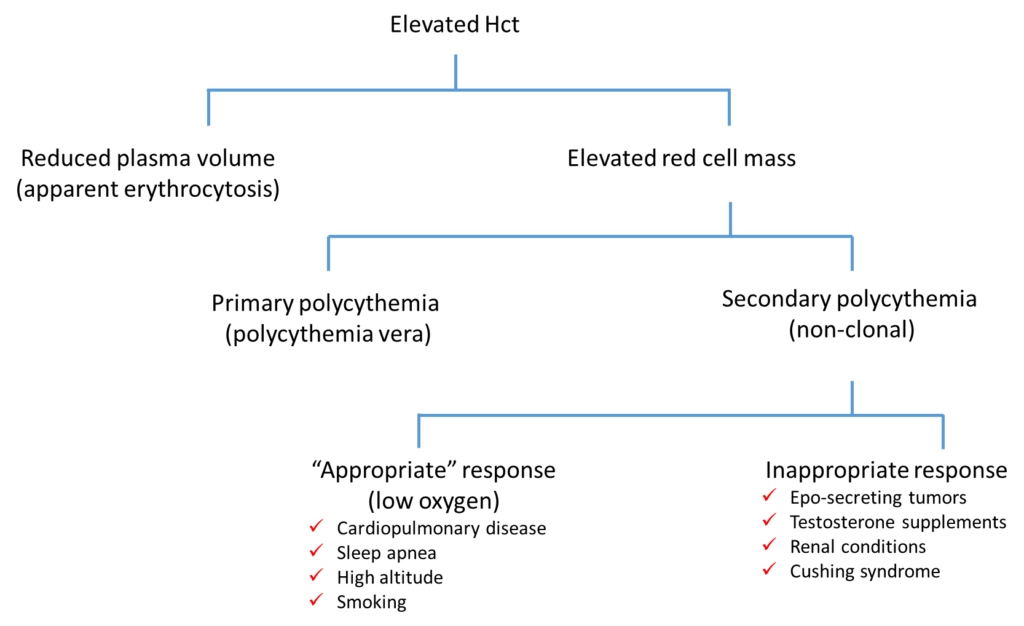History

A 72 year-old woman presented to her PCP with swelling and pain of her left elbow. A history revealed that she had been feeling unusually tired for the past 2-3 months, and she felt she was experiencing “brain fog” with difficulty concentrating and intermittent memory loss. A complete blood count (CBC) was performed and revealed an elevated Hct of 69.3%. She was promptly instructed to go to the emergency department for further work-up. In addition to the symptoms of elbow pain, fatigue and “brain fog”, she tells you that she has noted the palms of her hand to be redder than usual. She has also had several episodes of dizziness after showering over the past 6 months. She denies facial plethora, difficulty with vision, headache, bleeding, easy bruising, fevers, night sweats or change in weight. She has no other active medical problems. There is no family history of elevated Hct or other hematological conditions. She is a non-smoker and denies any alcohol intake. She is a retired restaurant worker. She is not taking any medications and has no known drug allergies.
A good history includes important negatives and positives. The history above mentions dizziness with showering.
To properly evaluate the appropriate positives and negatives on history, we need to consider the differential diagnosis of an elevated Hct and work our way backwards.


Let’s reorganize the algorithm of causes into table format and reconsider the history (over and above asking about symptoms of hyperviscosity which are common to all causes):
| Cause of elevated Hct | Symptoms |
|---|---|
| Apparent erythrocytosis | Do you have a recent history of vomiting, diarrhea, diuretic intake, burns, or fever? |
| Polycythemia vera | Do you have itchiness, especially after exposure to water? |
| Cardiopulmonary disease | Do you have a history of heart disease and/or lung disease, or symptoms of cough, shortness of breath, orthopnea, paroxysmal nocturnal dyspnea or swelling of the ankles? |
| Sleep apnea | Do you snore at night? Do you feel tired and take naps during the day? Have you ever had a sleep study? |
| Smoking | Do you smoke cigarettes? If so, how many and for how long? |
| Epo-secreting tumors | Have you ever been diagnosed with a tumor in the liver, kidney, brain or uterus. Do you have heavy periods or documented uterine fibroids? |
| Testosterone supplements | Do you take testosterone supplements, either for a medical indication (“low T”) or for boosting your muscle bulk? |
| Renal conditions | Have you ever been diagnosed with a kidney condition of any kind? Have you noticed any blood in your urine? |
The previous table above is focused on acquired causes of an elevated Hct. There are also rare congenital etiologies, thus the importance of asking the patient about a diagnosis during childhood and a family history of polycythemia.
You ask these questions of the patient, and she denies all.
Before moving on, let’s talk about definitions, so we are all on the same page.
- Elevated Hct:
- Hct above the 97.5th percentile.
- Hct > 52% in men and > 48% in women persisting > 2 months should prompt further investigation to determine cause of erythrocytosis.
- Erythrocytosis:
- Apparent erythrocytosis:
- Also called relative erythrocytosis.
- Elevated hematocrit owing to contracted plasma volume (red cell mass is normal).
- Most often due to dehydration.
- Absolute erythrocytosis:
- Red cell mass > 25% above that predicted for sex and body mass.
- Since red cell mass is rarely measured, an operational definition is simply the presence of an elevated Hb and Hct without evidence of plasma volume contraction (Hb and Hct are surrogate markers for red cell mass).
- Hct > 60% in men or > 56% in women almost always reflect increased RCM that is > 25% above normal predicted red cell mass.
- Primary erythrocytosis – absolute erythrocytosis with increased red cell production due to autonomous proliferation caused by intrinsic abnormalities of red cell progenitor and precursor cells within the bone marrow.
- Secondary erythrocytosis – absolute erythrocytosis with increased red cell production driven by a factor external to the bone marrow, typically erythropoietin.
- Apparent erythrocytosis:
- Polycythemia – the term is used interchangeably with erythrocytosis.

